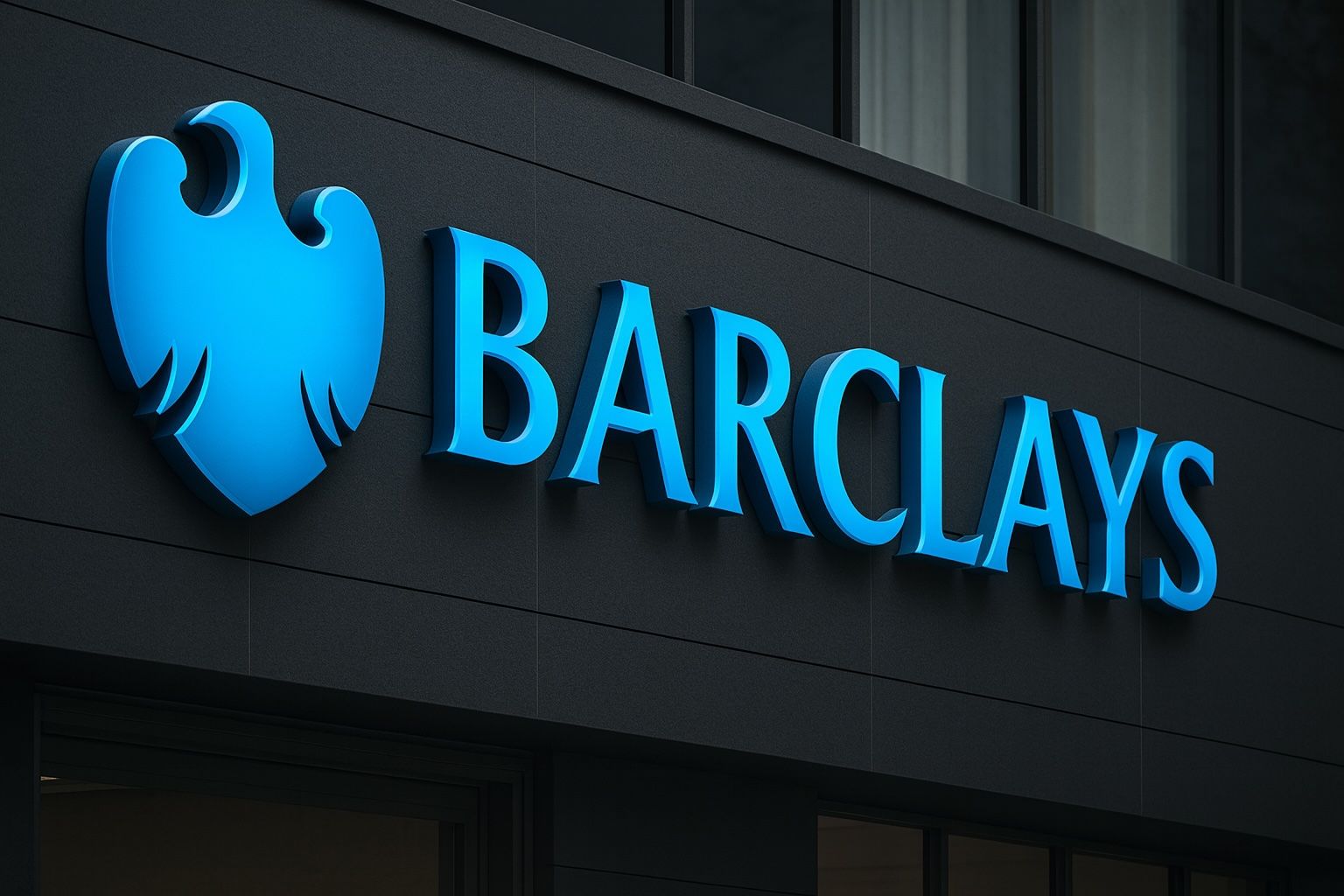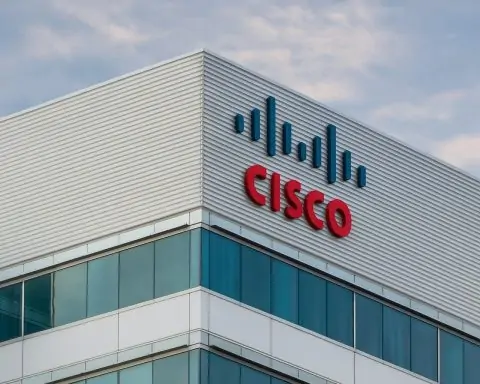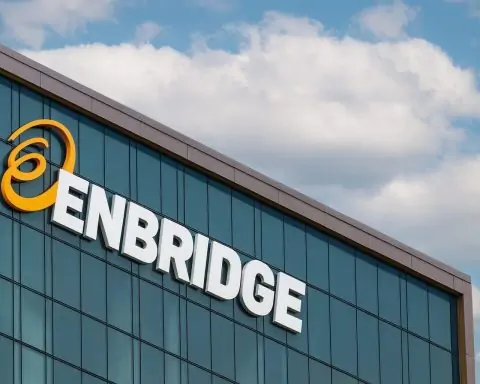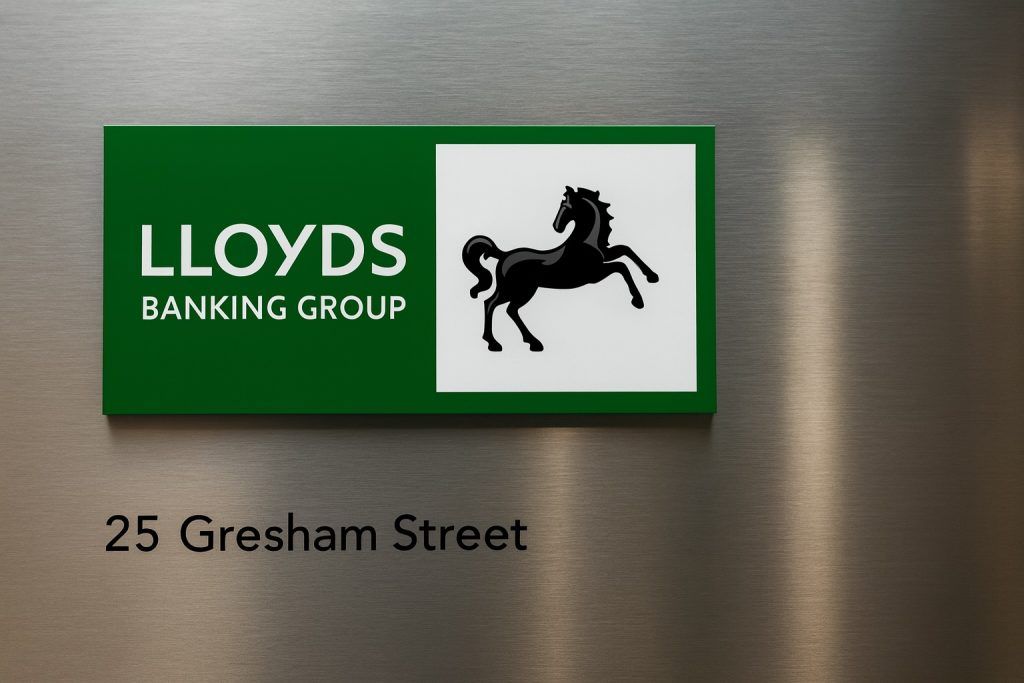Barclays PLC (LON: BARC) shares closed lower on Tuesday, 18 November 2025, as a global risk-off mood and UK budget jitters dragged banking stocks across the FTSE 100 into the red.
At the close in London, Barclays’ share price stood at around 400.10p, down roughly 2.6% from Monday’s close of 410.80p. [1]
At a Glance: Barclays Share Price on 18 November 2025
Based on closing data from Hargreaves Lansdown and other market sources: [2]
- Closing price (LSE, BARC): ~400.10p
- Previous close (17 Nov 2025): 410.80p
- Day’s approximate trading range: just under 396p to just above 401p
- Opening price: about 396.00p
- Market capitalisation: ~£55.7bn
- Volume: c. 7.8m shares traded
- 12‑month range: roughly 223.75p – 430.65p
- Trailing P/E ratio: ~11.4x
- Dividend yield: ~2.1%
Even after today’s pullback, the Barclays share price is still up around 55–60% over the past year, with Hargreaves Lansdown data showing a 58.4% one‑year gain and a 14.8% rise over the last month. [3]
Why Is the Barclays Share Price Down Today?
1. FTSE 100 selloff hits banks
Today’s move in Barclays came against a weak backdrop for UK equities:
- The FTSE 100 fell about 1%, marking its fourth straight day of declines and the longest losing streak since August. [4]
- Banks were among the biggest drags, with Barclays down around 2.5%, alongside declines in Standard Chartered, HSBC, Lloyds and NatWest. [5]
Global factors weighed heavily:
- A broad global equity selloff continued, with Asia‑Pacific markets sliding and Wall Street recording several consecutive down sessions. [6]
- Investors are increasingly nervous about:
In short, Barclays is moving with the market, not against it: today’s slide looks more like a sector‑wide risk-off move than a Barclays‑specific shock.
2. UK Budget and business sentiment are in focus
Domestic politics are also in play. The UK’s 26 November Budget is increasingly seen as a key risk event for businesses and markets:
- A Barclays Business Prosperity Index survey released today shows 55% of UK firms are pausing investment decisions until after the Budget. [9]
- Among small businesses (fewer than 50 employees), 45% of leaders say policy uncertainty is harming their firms, and many are building up precautionary cash buffers instead of borrowing to invest. [10]
This is a double‑edged sword for Barclays:
- Cautious SMEs can mean slower loan growth in the short term.
- But strong cash buffers and relatively resilient confidence (over 80% of firms still say they’re optimistic about the next 12 months) suggest the credit outlook isn’t collapsing. [11]
Budget uncertainty is feeding into wider market nerves, which is reflected in the bank-heavy FTSE 100 today.
Fresh Company News Today: Barclays’ Ongoing Share Buyback
The key Barclays-specific RNS on 18 November 2025 is an update on its share repurchase programme.
Transaction in own shares (RNS, 18 November)
Barclays announced that on 17 November 2025 it: [12]
- Bought back 3,892,466 ordinary shares on the London Stock Exchange.
- Paid between roughly 409.45p and 412.80p per share.
- Achieved a volume‑weighted average price (VWAP) of about 411.05p.
- Intends to cancel all of these repurchased shares.
Following cancellation:
- Issued share capital will stand at 13,928,215,121 ordinary shares, with no treasury shares. [13]
- Since the current buyback started on 30 July 2025, Barclays has repurchased about 241.8m shares at a VWAP of roughly 380.06p per share. [14]
Why this matters for the share price
The buyback sits within a £500m capital return programme unveiled with Q3 results, where Barclays said it would bring forward part of its 2025 distributions and move towards quarterly buyback announcements. [15]
Buybacks can support the share price over time by:
- Reducing the share count, boosting earnings per share (EPS) and return on tangible equity (RoTE).
- Signalling management confidence in the bank’s capital position and profitability.
- Providing downside cushioning during market selloffs as the company itself is a large buyer of its own stock.
Today’s RNS doesn’t fundamentally change the investment case, but it underlines that Barclays is actively shrinking its equity base at prices only slightly above where the shares are trading now.
New Policy News: Enhanced Paternity Leave
Separately, Barclays today announced a significant enhancement to its paternity and non‑primary caregiver leave policies, including: [16]
- More generous paternity leave in the UK.
- Improved non‑primary caregiver leave in parts of Asia.
While this is primarily an HR and culture story rather than a direct share price driver, it feeds into:
- Barclays’ employer brand and ability to compete for talent.
- Its wider ESG narrative, which some institutional investors now pay close attention to.
Regulatory Backdrop: Bank of England Ring‑Fencing Review
One of the most notable regulatory stories today is a Reuters report on the Bank of England’s stance on the UK’s ring‑fencing regime – rules that force big banks to separate retail banking from riskier activities like investment banking. [17]
Key points:
- The BoE is preparing to ease some aspects of ring‑fencing, such as allowing:
- Certain back‑office functions to be shared between ring‑fenced and non‑ring‑fenced entities.
- Some “vanilla” derivatives activities inside the ring‑fenced bank. [18]
- However, the BoE opposes major reforms sought by lenders that would let them use ring‑fenced retail deposits to fund other activities, arguing that would effectively “take down the fence”. [19]
- The regime applies to UK banks with more than £35bn in retail deposits, including Barclays, Lloyds, NatWest, HSBC and Santander UK. [20]
- Interestingly, the article notes that Barclays is the only major British lender explicitly in favour of the current rules, having already built a dedicated services division to support both its retail and investment banks. [21]
For investors, the takeaway is that:
- Regulatory clarity is slowly improving, but
- A full dismantling of ring‑fencing remains unlikely, limiting how far UK banks can go in reshaping their balance sheets.
For Barclays, already structurally aligned with ring‑fencing, the changes may actually reinforce its strategic positioningversus peers that would prefer looser rules.
Fundamentals: Where Barclays Stands After Q3 2025
Today’s price move sits on top of a strong fundamental re‑rating that has unfolded through 2024–25.
Q3 2025 results snapshot
In October, Barclays reported Q3 2025 numbers that were solid on income, but mixed on profits due to higher costs and provisions: [22]
- Total income: ~£7.2bn, up around 9–11% year‑on‑year.
- Net income attributable to ordinary equity holders: about £1.46bn, down ~6–7% year‑on‑year as operating costs and credit impairment charges rose. [23]
- Pre‑tax profit: roughly £2.1bn, down 7% from the prior year, partly due to:
- Additional provisions relating to motor finance misconduct, and
- A loss tied to the collapse of US firm Tricolor, highlighting some risks in private credit. [24]
- Credit impairment charges: around £632m in the quarter, up nearly 70% year‑on‑year. [25]
- Capital: Common Equity Tier 1 (CET1) ratio at about 14.1%, up from 13.6% at the end of 2024. [26]
The bank also:
- Upgraded its RoTE guidance for 2025 to >11% and signalled a path to >12% in 2026. [27]
- Confirmed gross cost‑efficiency savings of roughly £500m for 2025, one quarter ahead of schedule. [28]
Motor finance redress: a key risk that now looks more manageable
One overhang has been the UK motor finance mis‑selling saga. Today’s share price sits in the context of a regulatory process that is gradually becoming clearer:
- Earlier this year, the FCA proposed an industry‑wide compensation scheme for motor finance customers, estimating potential redress of up to £8.2bn across the sector. [29]
- RBC analysis cited by Investing.com suggested that Barclays’ portion of necessary provisions might be relatively modest at around £80m, much lower than for Lloyds or Santander UK. [30]
- The consultation on the scheme is due to close on 18 November 2025 – i.e., today – with final rules expected in early 2026. [31]
While the final cost is not yet locked in, markets have become more comfortable that Barclays’ exposure is manageable, particularly in light of its strong capital and earnings power.
Valuation and Analyst Views
From a valuation perspective, today’s close leaves Barclays in an interesting spot:
- P/E ratio of ~11.4x trailing earnings, which is still a discount to many global peers despite the past year’s big rally. [32]
- Dividend yield around 2.1%, modest for a UK bank but complemented by significant buybacks. [33]
- The share price is trading a few percentage points below recent record highs, with the 12‑month high just above 430p, and today’s close near 400p. [34]
On the sell‑side:
- Investing.com and other data aggregators show an average 12‑month price target around the mid‑440p area, implying upside in the low‑teens from current levels, with most analysts rating the stock as a “Buy” or equivalent. [35]
Of course, price targets are not guarantees — they simply reflect a consensus of models built on assumptions about rates, credit quality, capital rules and macro growth.
What Today’s Move Could Mean for Investors
For anyone tracking the Barclays share price today, a few themes stand out:
- Macro, not micro, is in the driving seat.
The fall in Barclays mirrors a wider selloff in global equities and UK banks, driven by AI‑bubble worries, rate‑cut repricing, crypto volatility and Budget uncertainty rather than a new company‑specific shock. [36] - Buyback is quietly tightening the share base.
Barclays is actively buying back and cancelling shares at levels slightly above today’s price, which supports EPS and RoTE and puts a floor under valuations over the medium term. [37] - Regulatory and policy risks remain, but are clearer.
Between the motor finance redress scheme, the ring‑fencing review, and the upcoming Budget, UK banks remain in a heavily regulated environment – but investors now have more concrete timelines and parameters to model. [38] - Performance has been stellar — pullbacks will attract debate.
After a roughly 60% 12‑month rally and a near‑tripling over five years, today’s drop will inevitably spark questions about whether this is: [39]- A healthy pause in an ongoing re‑rating, or
- The start of a more meaningful consolidation if the macro backdrop worsens.
Final word
Barclays’ share price on 18 November 2025 reflects a tug‑of‑war:
- On one side: robust earnings, rising returns, strong capital ratios and a sizeable buyback that keeps shrinking the share count.
- On the other: macro jitters, policy uncertainty around the UK Budget, and lingering concerns over credit quality and regulation.
For now, today’s slide to around 400p looks more like a market‑driven wobble than a turning point in the Barclays story – but with global volatility and UK policy decisions still in flux, investors will be watching the next data points closely.
Disclaimer: This article is for information and news purposes only and does not constitute investment advice or a recommendation to buy or sell any security.
References
1. www.hl.co.uk, 2. www.hl.co.uk, 3. www.hl.co.uk, 4. www.tradingview.com, 5. www.tradingview.com, 6. www.theguardian.com, 7. www.theguardian.com, 8. www.theguardian.com, 9. www.the-independent.com, 10. www.the-independent.com, 11. www.the-independent.com, 12. www.investegate.co.uk, 13. www.investegate.co.uk, 14. www.investegate.co.uk, 15. www.nasdaq.com, 16. www.publicnow.com, 17. www.reuters.com, 18. www.reuters.com, 19. www.reuters.com, 20. www.reuters.com, 21. www.reuters.com, 22. www.nasdaq.com, 23. www.nasdaq.com, 24. www.reuters.com, 25. www.nasdaq.com, 26. www.nasdaq.com, 27. home.barclays, 28. home.barclays, 29. www.investing.com, 30. www.investing.com, 31. www.investing.com, 32. www.hl.co.uk, 33. www.hl.co.uk, 34. www.hl.co.uk, 35. www.investing.com, 36. www.tradingview.com, 37. www.investegate.co.uk, 38. www.reuters.com, 39. www.hl.co.uk







